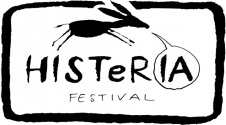HISTeRIA Festival
Concept
The one central idea behind the festival is of incorporating. It tries to involve people from the local village by setting up performances and workshops in the village itself; it tries to be friendly to the elderly, to the children and to the disabled; it is international and multilingual; it encourages visitors to be involved in the realisation of the festival; and it hosts numerous types of artists and other creative spirits, who bring a variety of art forms, art methods and throughout the whole day and night allow for both mindless as well as thoughtful and reflective entertainment.
An important part of the festival is the make and the design of the ambient. It takes place before the official festival starts and is yet still a part of it, as the artists and volunteers gather for a conceptually minded setting up of the site. Land-art, the usage of the in situ materials and also the already existing 'spots', environment friendly practices and a general feel-good aesthetics are the principles, by which the location is manipulated and adjusted into the festival grounds.
Principles
An underlying mode of production, which allows for all of this to happen, is voluntarism. Not only do the organisers and their helping team work for free, so do the artists and others involved in the festival, and only some of the mentors for specific projects get paid for their travel expanses. This does not only enable the festival to happen and draws the people that really want to be there for the social and cultural experience, it also makes it possible to invest the profits into expanding and enriching the next years edition.
Last but not least is the principle of sustainability. All the waste produced is recycled, the festival goes for minimal energy consumption and the participants are encouraged not to litter the floor with neither cigarette stubs nor, of course, anything bigger.
{{#oembed:https://www.youtube.com/watch?v=ZN8y7lBaVHg%7C576}}
Programme
The vast programme involves different performances, concerts, puppet shows, circus acts, street theatre, workshops for adults and children, poetry, exhibitions, a forest funfair and a labyrinth, film projections and more. The 2013 edition, for example, involved more than 700 artists and 150 volunteers from 25 countries.
The festival also lives before and after the festival, and in the week before it happened, some of the artists were already warming up and performing in various cities and towns of Slovenia. The Etno HISTeRIA Orchestra even had a protest in front of the Centre for Foreigners just before the 2013 edition, demanding basic human rights for the detented individuals and questioning the existing policies concerning the immigrants.



